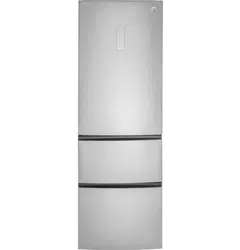Documents: Go to download!
User Manual
- User Manual - (English, French, Spanish)
- Energy Guide - (English)
- Quick Specs - (English)
- USING THE REFRIGERATOR
- CARE AND CLEANING
- TROUBLESHOOTING TIPS
Table of contents
User manual Refrigerator
USING THE REFRIGERATOR
Controls
The control location for GLE12HSLSS model is on the outside of the Fresh Food door. For GLE12HSPSS model, it is on the left side wall of the inside of the Fresh Food compartment.
Refrigerator Temperature Control
This refrigerator has 3 temperature zones: Fridge, Freezer, TempZone. Their temperature ranges are: Fridge 33°F (0.6°C) to 41°F (5°C), Freezer -6°F (-21°) to 6°F (-14.4°), TempZone 32°F (0°C), 34°F (1.1°C), 36°F (2.2°C). Your refrigerator will come with the recommended factory setting at 37°F (2.8°C) for Fresh Food, 0°F (-17.8°C) for Freezer and 32°F (0°C) for TempZone pan. Temperature display will show the actual set temperature and the zone light (Fridge, Freezer or TempZone) will be on.
To adjust the Temperature for each zone, press Zone Select. The selected zone light will be on. Keep pressing to toggle between 3 temperature zones. Zone will be set after 3 seconds. Adjust the temperature by pressing Temp Control. The temperature display will show the temperature moving up as you press it. Once you find the temperature you want, the control will automatically set the refrigerator to this setting. You don’t need to press any button.
TurboCool and TurboFreeze
During TurboCool, refrigerator temperature can reach 33°F (0.6°C). During TurboFreeze, freezer temperature can reach 13°F (-10.6°) if room temperature is above 73°F (22.8°C), -7°F (-21.7°C) if room temperature is below 73°F (22.8°C).
To enter TurboCool or TurboFreeze or both, press mode. TurboCool will light up. If you leave without pressing any button, TurboCool will be set. Pressing mode a second time will light up TurboFreeze; leave without pressing any button, TurboFreeze will be set.
Pressing mode a third time will light up both TurboCool and TurboFreeze; leave without pressing any button, both functions will be set.
To exit Turbo functions, press mode again.
NOTE: During Turbo modes, the refrigerator or freezer temperature can be adjusted..
Lock
Press the lock symbol, hold for 3 seconds. The circle around the lock symbol with light up and the control display will be locked. Buttons will not be active.
To exit the lock, press the lock symbol again and hold for 3 seconds. The light around the lock will go off.
NOTE: The display will turn off after 30 seconds if the control display has not been touched. Touch any button on the control panel and it will display again.
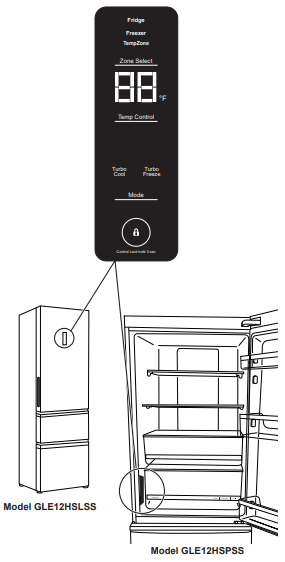
Sabbath Mode
Press the ZoneSelect and Temp Control simultaneously for 5 seconds to enter and exit Sabbath Mode. Activate Sabbath Mode to turn off interior lights, temperature control and advanced features. The compressor will run on a timed defrost when in Sabbath Mode. Sabbath Mode will last for 76 hours if you do not manually exit the mode.
Shelves and Racks and Pans
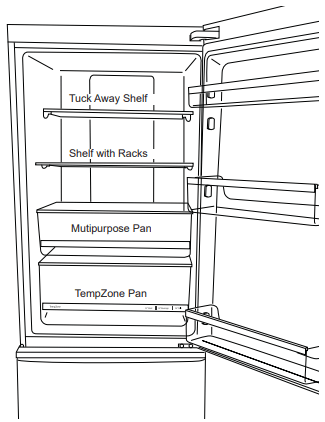
Tuck Away Shelf
To create space for large tall milk and drink bottles.
Lift the back of the front shelf, pull out slightly and release the shelf. The back of the shelf will drop down automatically. Push the front shelf underneath the back shelf.
To remove the shelf, lift the front frame out of the clips and pull out.
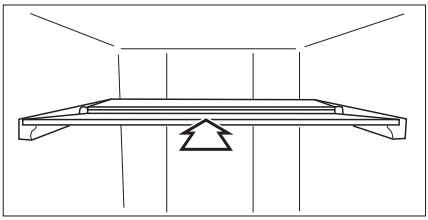
Shelf with Racks
Rotate both wine racks down as picture shown for wine storage. This shelf can be adjust to 2 locations
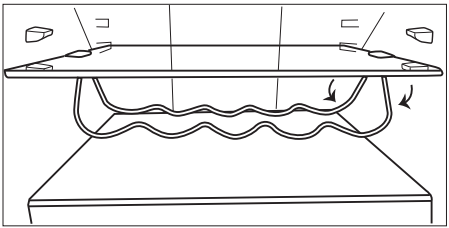
CAUTION Do not clean glass shelves or covers with warm water when they are cold. Glass shelves and covers may break if exposed to sudden temperature changes or impact such as bumping or dropping. Tempered glass is designed to shatter into many small pieces if it breaks.
NOTE: Do not block air outlet by placing food items directly against it. Erratic temperatures may result.
Multipurpose Pan
This pan can use for storing vegetable, fruit, snack etc. To remove, pull the pan straight out.
TempZone Pan
Adjust the pan temperature through temperature control panel. This pan can have 3 temperature settings 32°F, 34°F, 36°F (0°C, 1.1°C, 2.2°C). It can be used as meat pan when it set at lowest temperature.

To remove TempZone pan, pull out pan (1), lift the pan cover slightly (2), tilt the pan up (3), pull the pan out (4).
To remove the pan cover, simply pull them straight out.

Door Bins
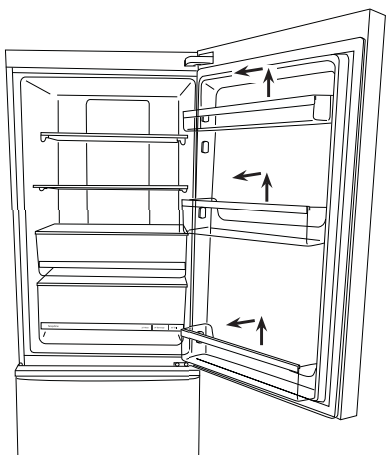
Fridge Door Bins
To remove door bins, slide bin up over the rib in the door and pull out.
To install door bins, slide the bin over the rib in the door. The small bin goes at the top on either set of ribs. Large bins go at the bottom and in the middle.
NOTE: Placing the door bins in the wrong locations will
cause the Fresh Food door not to close.
Freezer Drawers
Upper Drawer
The divider can be placed in 2 positions for better organization of the drawer. Lift the divider out to remove it. Slip it over one of the 2 ribs in the drawer to install.
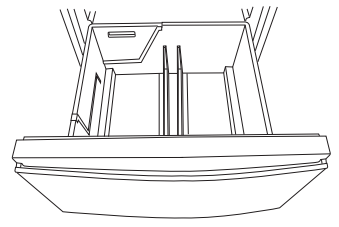
Lower Drawer
The lower drawer has a removable tray that slides back and forth to make more storage space. To remove the tray, lift it out of the drawer.
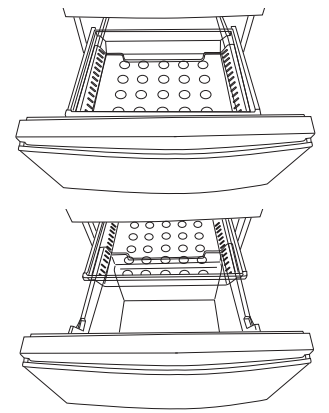
CARE AND CLEANING
Cleaning the Outside
Directions for Cleaning Outside Surfaces, Door Handles, and Trim
DO USE | DO NOT USE |
| Soft, clean cloth or sponge | Abrasive cloths, scrubbing sponges, scouring or steel wool pads |
Mild detergent mixed with warm water Cleaners with oxalic acid such as Bar Keepers Friend Soft Cleanser™ can be used to remove surface rust, tarnish and small blemishes on stainless steel surfaces only. | Abrasive powders or sprays Window Sprays or Ammonia Citrus or plant oil-based cleaners Acidic or vinegar-based cleaners Oven cleaners Cleaners containing acetone (propanone) Any cleanerwith WARNING about plastic contact |
NOTE: DO NOT allow stainless steel cleaner to come in contact with any plastic parts such as trim pieces, handle hardware and liners. If unintentional contact of cleaners with plastic parts does occur, clean plastic part with a sponge and mild detergent mixed with warm water.
Cleaning the Inside
To help prevent odors, leave an open box of baking soda in the fresh food and freezer compartments.
Unplug the refrigerator before cleaning.
If this is not practical, wring excess moisture out of sponge or cloth when cleaning around switches, lights or controls.
Use warm water and baking soda solution—about a tablespoon (15 ml) of baking soda to a quart (1 liter) of water. This both cleans and neutralizes odors. Rinse and wipe dry.
After cleaning the door gaskets, apply a thin layer of petroleum jelly to the door gaskets at the hinge side. This helps keep the gaskets from sticking and bending out of shape.
Warning Do not clean glass shelves or covers with warm water when they are cold. Glass shelves and covers may break if exposed to sudden temperature changes or impact such as bumping or dropping. Tempered glass is designed to shatter into many small pieces if it breaks.
Do not wash any plastic refrigerator parts in the dishwasher.
Moving the Refrigerator
Be careful when moving the refrigerator away from the wall. All types of floor coverings can be damaged, particularly cushioned coverings and those with embossed surfaces.
Pull the refrigerator straight out and return it to position by pushing it straight in. Moving the refrigerator in a side direction, or leaning the unit to the corner to pull or push, may result in damage to the floor covering or refrigerator.
When pushing the refrigerator back, make sure you don’t roll over the power cord or ice maker supply line (on some models).
Adjust leveling legs and make sure the unit is leveled.
Light
This refrigerator has LED lighting. Call service if the light is broken or goes out.
The freezer light, located under the fresh food door, will only be on when the upper freezer drawer is open. No light will be on when the lower freezer drawer is open.
Preparing for Vacation
For long vacations or absences, remove food and unplug the refrigerator. Unplug the refrigerator. This refrigerator will remember the current setting when you plug it in again. Clean the interior with a baking soda solution of one tablespoon (15 ml) of baking soda to one quart (1 liter) of water. Leave the doors open.
If an icemaker has been installed it must be turned off; move the switch to the OFF position on the power switch model. Shut off the water supply to the refrigerator.
If the temperature can drop below freezing, have a qualified servicer drain the water supply system (on some models) to prevent serious property damage due to flooding.
Preparing to Move
Secure all loose items, such as shelves and drawers, by taping them securely in place to prevent damage.
To prevent the doors from opening while moving, secure them to the case with tape. Be sure the refrigerator stays in an upright position during moving.
TROUBLESHOOTING TIPS
Troubleshooting Tips... Before you call for service
Problem | Possible Causes | What to Do |
Refrigerator does not operate | Refrigerator in defrost cycle. | Wait about 30 minutes for defrost cycle to end. |
Either or both controls set to OFF | Set the controls to a lower temperature setting. | |
Refrigerator is unplugged. | Push the plug completely into the outlet. | |
The fuse is blown/circuit breaker is tripped. | Replace fuse or reset the breaker. | |
Motor operates for long periods or cycles on and off frequently. (Modern refrigerators with more storage space and a larger freezer require more operating time. They start and stop often to maintain even temperatures.) | Normal when refrigerator is first plugged in. | Wait 24 hours for the refrigerator to completely cool down. |
Often occurs when large amounts of food are placed in refrigerator. | This is normal. | |
Door left open. | Check to see if package is holding door open. | |
Hot weather or frequent door openings. | This is normal. | |
Temperature controls set at the coldest setting. | See Temperature Control section. | |
Refrigerator or freezer compartment too warm | Temperature control not set cold enough. | See Temperature Control section. |
Warm weather or frequent door openings. | Set the temperature control one step colder. See Temperature Control section. | |
Door left open. | Check to see if package is holding door open. | |
Frost or ice crystals on frozen food (frost within package is normal) | Door left open. | Check to see if package is holding door open. |
Too frequent or too long door openings. | This is normal. | |
Divider between refrigerator and freezer compartments feels warm. | Automatic energy saver system circulates warm liquid around the front edge of the freezer compartment. | This helps prevent condensation on the outside. |
Automatic ice maker does not work (if installed). | Ice maker power switch is in the OFF position. | Set the power switch to ON position. |
Water supply turned off or not connected. | See Installing the water line section of the ice maker installation instructions. | |
Freezer compartment too warm. | Wait 24 hours for the refrigerator to completely cool down. | |
Piled up cubes in the storage bin cause the ice maker to shut off. | Level cubes by hand. | |
Ice cubes stuck in ice maker. | Turn offthe ice maker, remove cubes, and turn the ice maker back on. | |
Ice cubes have bad odor/taste | Ice storage bin needs cleaning. | Empty and was bin. Discard old ice. |
Food transmitting odor/taste to ice | Wrap foods well. | |
Interior of refrigerator needs cleaning. | See Care and Cleaning section. | |
Slow ice cube freezing | Door left open. | Check to see if package is holding door open. |
Problem | Possible Causes | What to Do |
Frequent buzzing sound from the ice maker (if installed). | Ice maker power switch is in the ON position but the water supply to the refrigerator has not been connected. | Set the power switch to the OFF position. Keeping it in the ON position will damage the water valve. |
No ice cube production (if ice maker is installed). | Supply line or shutoff valve is clogged. | Call a plumber. |
Refrigerator has odor. | Foods transmitting odor to refrigerator. | Foods with strong odors should be tightly wrapped. |
Keep an open box of baking soda in the refrigerator; replace every 3 months. | ||
Interior needs cleaning. | See Care and Cleaning section. | |
Moisture forms on outside of refrigerator. | Not unusual during periods of high humidity. | Wipe surface dry. |
Moisture collects inside (in humid weather, air carries moisture into refrigerator when doors are opened) | Due to the higher humidity in the refrigerator, you may on occasion experience fog or small amounts of moisture in the refrigerator compartment. | This is normal and may come and go as different food loads and environmental conditions change. Wipe dry with a paper towel if desired. |
Interior light does not work | No power at the outlet. | Replace fuse or reset the breaker. |
Light bulb is burned out. | See Care and Cleaning section. | |
Hot air from the bottom of the refrigerator | Normal airflow cooling motor. In the refrigeration process, it is normal that heat be expelled in the area under the refrigerator. Some floor coverings are sensitive and will discolor at these normal and safe temperatures. | This is normal. |
Refrigerator never shuts off but the temperatures are ok. | Adaptive defrost keeps compressor running during door openings. | This is normal. The refrigerator will cycle off after the door remains closed for 2 hours. |
Door not closing properly. | Door gasket on hinge side sticking or folding over. | Apply paraffin wax to the face of the gasket. |
Door does not close by itself | Leveling legs need adjusting. | See Rollers and Leveling Legs in the Installation instructions section. |
Freezer door opens when refrigerator door is closed. | This is normal if the door closes after it pops open. | This indicates that there is a good seal on the freezer door. If the freezer door does not automatically close after popping open, then see Door does not close by itself, above. |
Food freezing in the refrigerator. | Food too close to the air vent at the back of the refrigerator. | Move food away from the air vent. |
Refrigerator control is set too cold. | Move the refrigerator control to a warmer temperature. | |
Handle is loose/handle has a gap. | Handle needs to be adjusted. | See Reversing Door Handles in the Installation Instructions section. |
See other models: GSS25JETACC BSY25GFMCWW JGP337BEJ3BB JTP35DP3WW DCVH680GJ0WW
